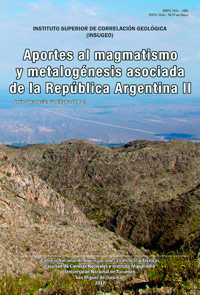Serie Correlación Geológica 28 (2)
Caracterización geoquímica del granito El Durazno, extremo norte de la sierra de Velasco, La Rioja
Miguel A. Báez | Ana S. Fogliata | Steffen Hagemann | Fernando G. Sardi
Descargar trabajo en formato PDFResumen
El área de estudio se ubica en el norte de la sierra de Velasco, en la provincia de La Rioja. Está compuesta principalmente por rocas graníticas que cristalizaron durante dos eventos magmáticos principales en el Ordovícico y el Carbonífero. Los granitos más antiguos presentan diferentes grados de deformación y los más jóvenes no están deformados. Los granitos datados como carboníferos hasta el presente en este sector son Asha y San Blas. Este último presenta una zona central más evolucionada químicamente, asociado a mineralizaciones de Sn. El granito El Durazno aflora al sureste del granito San Blas, no está deformado e intruye al ortogneis Antinaco, compuesto por rocas deformadas del Ordovícico. Es un granito postorogénico, peraluminoso y fuertemente diferenciado, con contenidos de Na2O>K2O. Presenta altos contenidos en Rb, Li, W, Cs, Nb y Ta y bajos en Ba, Sr, Y, Zr y Ce. El índice de caracterización geoquímica (GCI) para granitos asociados a mineralizaciones de W da valores positivos mayores que 4. Las tierras raras presentan contenidos totales bajos, entre 5,3 y 15,3 ppm, anomalía negativa de Eu y efecto tetrada convexo. En el borde norte del granito El Durazno existen vetas de cuarzo con wolframita y hematita distribuidas irregularmente que intruyen al ortogneis Antinaco. Tienen rumbo aproximado N-S y una corrida irregular. La ausencia de deformación, relaciones de campo y características geoquímicas indican que el granito El Durazno es un intrusivo muy diferenciado asociado a mineralización de W y de posible edad carbonífera.
Abstract
GEOCHEMICAL CHARACTERIZATION OF EL DURAZNO GRANITE, NORTHERN SIERRA DE VELASCO, LA RIOJA. The studied area is located in the north of the sierra de Velasco, La Rioja province. It is mainly composed of granitic rocks that crystallized during two main magmatic events in the Ordovician and Carboniferous. The older granites have different types of deformation whereas the younger granites are not deformed. Two Carboniferous granites have been dated in this area: Asha and San Blas. The latter has a chemically evolved central zone related to Sn mineralization. The El Durazno undeformed granite outcrops southeast of the San Blas granite, and intrudes into the deformed Ordovician Antinaco orthogneiss. It is a postorogenic, peraluminous and strongly differentiated granite, with contents of Na2O>K2O. It has high values of Rb, Li, W, Cs, Nb and Ta, and low values of Ba, Sr, Y, Zr and Ce. The geochemical characterization index (GCI) for W-bearing differentiated granites is positive with values greater than 4. The REE show low total contents, between 5,3 and 15,3 ppm, negative Eu anomalies and a convex tetrad effect. At the northern border of the El Durazno granite, quartz veins with irregularly distributed wolframite and hematite cross-cut the Antinaco orthogneiss. The veins have irregular north-south strike. The absence of deformation, field relations and geochemical characteristics indicate that the El Durazno granite is a highly differentiated intrusive associated with W mineralization and of possible Carboniferous age.






